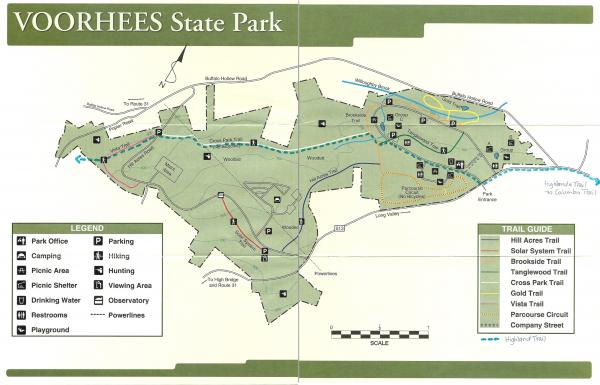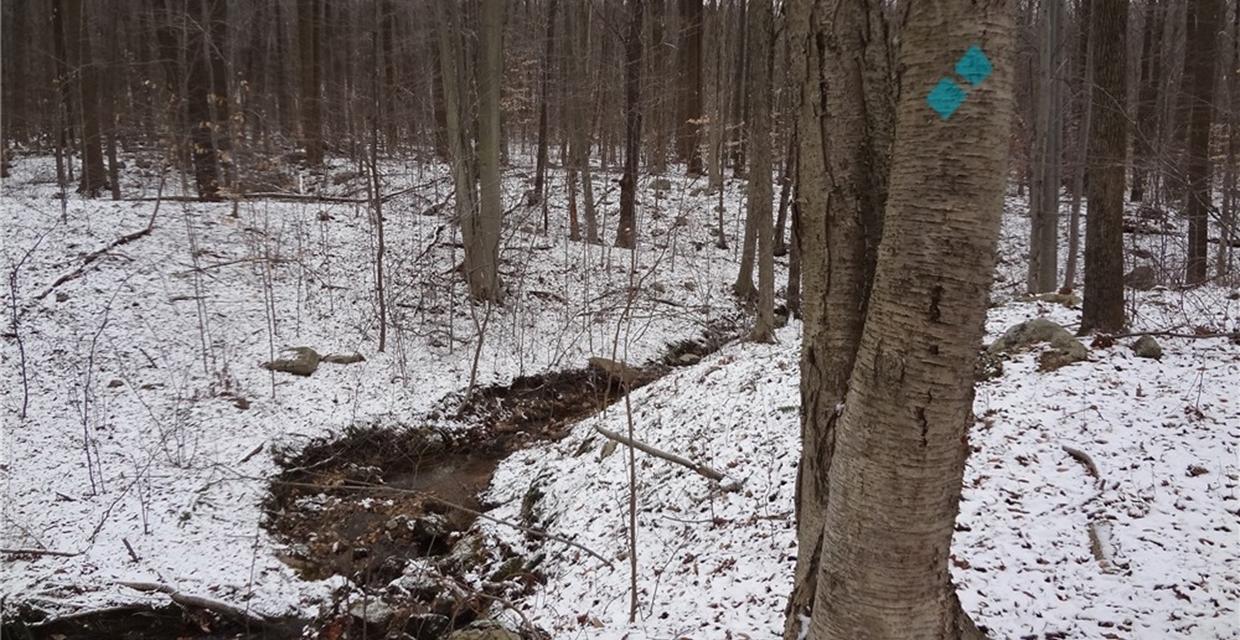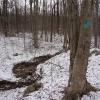From the parking lot walk back across the park road to the footbridge and cross over following the teal diamond blazes of the Highlands Trail. After a short distance, come to a T-intersection and turn right. Follow teal/white/orange then keep left on teal/white when the orange-blazed Brookside Trail leaves to the right. For the next mile and a half the Highlands Trail will follow the white-...
Hike Description:
From the parking lot walk back across the park road to the footbridge and cross over following the teal diamond blazes of the Highlands Trail. After a short distance, come to a T-intersection and turn right. Follow teal/white/orange then keep left on teal/white when the orange-blazed Brookside Trail leaves to the right. For the next mile and a half the Highlands Trail will follow the white-blazed Cross Park Trail but you will be seeing more teal diamond blazes than white trail markers. The trail meanders through mixed hardwood forests with multiple rock hops over small creeks. 1.2 miles into the hike, the trail turns right in a power cut, follows the power cut briefly, then leaves to the left back into the woods.
At the 1.5 mile point, the white-blazed Cross Park Trail ends at a paved park road. Continue following the teal blazes to the left along the park road for a short distance then turn right on the Vista Trail, blazed infrequently with pink markers. The teal blazes, however, will guide the way until a fork with a cairn in .3 mile when the Highlands Trail leaves to the right. Keep left at this fork staying on the Vista Trail but there won’t be any markers for a while. Unless there is deep snow, the trail should be well defined enough to follow.
Although named the Vista Trail, it seems the vista is not that easy to find. When the leaves are down, there are obstructed views through the trees along this trail. The Vista Trail will start to ascend towards an old stone wall. Just before this wall, a trail not on the map comes in from the left. Turn right here and you should see a pink marker a short distance ahead to confirm you are on the right path. The pink markers become more frequent now.
You may do a double take in .2 mile when the trail passes between two piles of rocks. Take another look - the piles are actually a seating arrangement of matching armchairs made out of rocks!
In another .2 mile the Vista Trail ends at the paved park road. Turn right and walk along the park road keeping straight at the intersection. In just under half a mile turn right on the drive leading to the observatory, then left before the observatory to pick up the Solar System Trail. Several interpretive signs line this half-mile long trail.
Once again arrive at the same park road only this time in a parking lot at a picnic area. Turn right in the parking lot for a spectacular view of Round Valley Reservoir. You can see how high up the reservoir is situated from this viewpoint.
Continue on the park road in the direction you were heading watching to the left for the start of the multi-use Hill Acres Trail at a large sign across a small field. This trail will soon cross a power cut and then turn right at an unmarked intersection on a woods road. Keep following the Hill Acre Trail signs and blue trail markers until you arrive back at the junction with the Highlands Trail. Turn right on the Highlands Trail and cross over the footbridge back to your car.
Click here for more pictures of this hike .

Turn By Turn Description:
0.00 From the Hoppock Grove parking lot follow teal-blazed Highlands Trail over a footbridge
0.10 Turn right on teal/orange/white trail; stay on teal/white when orange leaves to the right
0.40 Cross footbridge
0.55 Rock hop over creek
0.65 Rock hop over creek
0.70 Rock hop over creek
1.05 Rock hop over creek
1.20 Teal/white turns right along power cut briefly before turning left back into woods
1.50 Turn left on paved park road when the white-blazed Cross Park Trail ends
1.55 Turn right on teal/pink trail at Vista Trail sign (pink blazes will be sporadic - mostly teal blazes along this part)
1.60 Cross creek on footbridge
1.70 Cross footbridge
1.85 At the fork with a cairn when teal Highlands Trail leaves to the right, keep left on pink (no pink markers at the fork)
2.05 Near the top of an incline with stone wall ahead, turn right when trail not on map comes in from left
2.20 Trail passes between 2 stone chairs; pink markers become more frequent
2.40 Turn right on paved park road; keep straight through the intersection with another paved road
2.85 Turn right towards observatory then left on Solar System Trail before observatory building
3.20 Solar System Trail ends in parking lot with scenic overlook of Round Valley Reservoir to right; continue to blue-blazed Hill Acres Trail through field on left (large sign)
3.30 Cross through power cut
3.50 When trail comes out at woods road, keep right (unmarked)
3.55 At well-marked intersection, turn right; blue-blazed Hill Acres Trail becomes gravel road
3.95 At intersection turn left following Hill Acres Trail sign
4.05 At intersection with teal-blazed Highlands Trail, turn right following teal blazes
4.10 Cross footbridge then park road back to parking lot


Follow part of the Highlands Trail through mixed hardwood forests on a footpath then on to a scenic overlook of Round Valley Reservoir and return on a multi-use woods road.
Hike Checklist:
Whether you are going for a day hike or backpacking overnight, it is good practice to carry what we call The Hiking Essentials. These essentials will help you enjoy your outing more and will provide basic safety gear if needed. There may also be more essentials, depending on the season and your needs.
The Essentials
Hiking Shoes or Boots
Water - Two quarts per person is recommended in every season. Keep in mind that fluid loss is heightened in winter as well as summer. Don't put yourself in the position of having to end your hike early because you have run out of water.
Map - Know where you are and where you are going. Many of our hiking areas feature interconnecting network of trails. Use a waterproof/tear-resistant Tyvek Trail Conference map if available or enclose your map in a Ziplock plastic bag. If you have a mobile device, download Avenza’s free PDF Maps app and grab some GPS-enhanced Trail Conference maps (a backup Tyvek or paper version of the map is good to have just in case your batteries die or you don't have service). Check out some map-reading basics here.
Food - Snacks/lunch will keep you going as you burn energy walking or climbing. Nuts, seeds, and chocolate are favorites on the trail.
Sunscreen and insect repellent
Rain Gear and Extra Clothing - Rain happens. So does cold. Be prepared for changing weather. Avoid cotton--it traps water against your skin and is slow to dry. If you are wearing wet cotton and must return to your starting point, you risk getting chills that may lead to a dangerous hypothermia. Choose synthetic shirts, sweaters and/or vests and dress in layers for easy on and off.
Compass - A simple compass is all you need to orient you and your map to magnetic north.
Light - A flashlight or small, lightweight headlamp will be welcome gear if you find yourself still on the trail when darkness falls. Check the batteries before you start out and have extras in your pack.
First Aid Kit - Keep it simple, compact, and weatherproof. Know how to use the basic components.
Firestarter and Matches - In an emergency, you may need to keep yourself or someone else warm until help arrives. A firestarter (this could be as simple as leftover birthday candles that are kept inside a waterproof container) and matches (again, make sure to keep them in a waterproof container) could save a life.
Knife or Multi-tool - You may need to cut a piece of moleskin to put over a blister, repair a piece of broken equipment, or solve some other unexpected problem.
Emergency Numbers - Know the emergency numbers for the area you're going to and realize that in many locations--especially mountainous ones, your phone will not get reception.
Common Sense - Pay attention to your environment, your energy, and the condition of your companions. Has the weather turned rainy? Is daylight fading? Did you drink all your water? Did your companion fail to bring rain gear? Are you getting tired? Keep in mind that until you turn around you are (typically) only half-way to completing your hike--you must still get back to where you started from! (Exceptions are loop hikes.)
Check the weather forecast before you head out. Know the rules and regulations of the area.
The Leave No Trace Seven Principles
Plan Ahead and Prepare
- Know the regulations and special concerns for the area you'll visit.
- Prepare for extreme weather, hazards, and emergencies.
- Schedule your trip to avoid times of high use.
- Visit in small groups when possible. Consider splitting larger groups into smaller groups.
- Repackage food to minimize waste.
- Use a map and compass to eliminate the use of marking paint, rock cairns or flagging.
Travel and Camp on Durable Surfaces
- Durable surfaces include established trails and campsites, rock, gravel, dry grasses or snow.
- Protect riparian areas by camping at least 200 feet from lakes and streams.
- Good campsites are found, not made. Altering a site is not necessary.
- In popular areas:
- Concentrate use on existing trails and campsites.
- Walk single file in the middle of the trail, even when wet or muddy.
- Keep campsites small. Focus activity in areas where vegetation is absent.
- In pristine areas:
- Disperse use to prevent the creation of campsites and trails.
- Avoid places where impacts are just beginning.
- Pack it in, pack it out. Inspect your campsite and rest areas for trash or spilled foods. Pack out all trash, leftover food and litter.
- Deposit solid human waste in catholes dug 6 to 8 inches deep, at least 200 feet from water, camp and trails. Cover and disguise the cathole when finished.
- Pack out toilet paper and hygiene products.
- To wash yourself or your dishes, carry water 200 feet away from streams or lakes and use small amounts of biodegradable soap. Scatter strained dishwater.
- Preserve the past: examine, but do not touch cultural or historic structures and artifacts.
- Leave rocks, plants and other natural objects as you find them.
- Avoid introducing or transporting non-native species.
- Do not build structures, furniture, or dig trenches.
- Campfires can cause lasting impacts to the backcountry. Use a lightweight stove for cooking and enjoy a candle lantern for light.
- Where fires are permitted, use established fire rings, fire pans, or mound fires.
- Keep fires small. Only use sticks from the ground that can be broken by hand.
- Burn all wood and coals to ash, put out campfires completely, then scatter cool ashes.
- Observe wildlife from a distance. Do not follow or approach them.
- Never feed animals. Feeding wildlife damages their health, alters natural behaviors, and exposes them to predators and other dangers.
- Protect wildlife and your food by storing rations and trash securely.
- Control pets at all times, or leave them at home.
- Avoid wildlife during sensitive times: mating, nesting, raising young, or winter.
Be Considerate of Other Visitors
- Respect other visitors and protect the quality of their experience.
- Be courteous. Yield to other users on the trail.
- Step to the downhill side of the trail when encountering pack stock.
- Take breaks and camp away from trails and other visitors.
- Let nature's sounds prevail. Avoid loud voices and noises.
The Trail Conference is a 2015 Leave No Trace partner.
(c) Leave No Trace Center for Outdoor Ethics: www.LNT.org.


